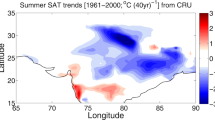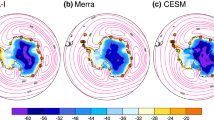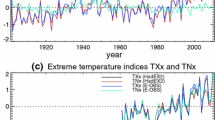Abstract
This study investigates the roles of anthropogenic forcing and internal variability in the recent rapid warming over the Tibetan Plateau (TP) using a 30-member ensemble of CESM1 simulations. The ensemble-mean surface air temperature (SAT) over the TP shows a warming trend, but there is a remarkable diversity among individual members, suggesting a strong effect of internal variability. The ratio of the ensemble mean to the standard deviation of SAT trends among the ensemble is larger than 3 in summer and ranges from 0.5 to 1.5 in winter over most regions of TP. Our analysis reveals that internal atmospheric variability exerts crucial influences on SAT increase over the TP in both summer and winter by modulating surface heat fluxes involving cloud-radiation and snow-albedo feedbacks. A fingerprint pattern matching method illustrates that internal variability has augmented the observed TP warming in recent decades due to anthropogenic forcing. Internal variability is estimated to account for 25% of the observed warming trend in summer and approximately 50% in winter over the TP. The dynamical adjustment method reveals that the enhanced warming in the observations over northeastern TP in summer and over central TP in winter is partly dynamically induced. Further analysis indicates that SAT changes over the TP are closely tied to the multidecadal fluctuation of the Silk Road Pattern-like and the Scandinavian Pattern-like atmospheric circulation anomalies in summer and winter, respectively.














Similar content being viewed by others
Data availability
The CESM1 simulations are available on earthsystemgrid.org. The ERA5 reanalysis data were obtained from https://cds.climate.copernicus.eu/#!/home. The JRA55 reanalysis data were obtained from https://rda.ucar.edu/datasets/ds628-1/. The SAT data of stations and CN05.1 are available from http://data.cma.cn/en.
References
Barnston AG, Livezey RE (1987) Classification, seasonality and persistence of low-frequency atmospheric circulation patterns. Mon Weather Rev 115:1083–1126
Bolch T, Kulkarni A, Kaab A, Huggel C, Paul F, Cogley JG, Frey H, Kargel JS, Fujita K, Scheel M, Bajracharya S, Stoffel M (2012) The State and Fate of Himalayan Glaciers. Science 336:310–314
Cai D, You Q, Fraedrich K, Guan Y (2017) Spatiotemporal temperature variability over the Tibetan Plateau: altitudinal dependence associated with the global warming hiatus. J Clim 30:969–984
Chen B, Chao WC, Liu X (2003) Enhanced climatic warming in the Tibetan Plateau due to doubling CO2: A model study. Clim Dyn 20(4):401–413
Cui X, Graf HF (2009) Recent land cover changes on the Tibetan Plateau: A review. Clim Change 94:47–61
Cui X, Graf HF, Langmann B, Chen W, Huang R (2006) Climate impacts of anthropogenic land use changes on the Tibetan Plateau. Glob Planet Change 54:33–56
Deser C, Knutti R, Solomon S, Phillips AS (2012) Communication of the role of natural variability in future North American climate. Nat Clim Chang 2:775–779
Deser C, Phillips AS, Alexander MA, Smoliak BV (2014) Projecting North American climate over the next 50 Years: Uncertainty due to internal variability. J Clim 27:2271–2296
Deser C, Terray L, Phillips AS (2016) Forced and internal components of winter air temperature trends over North America during the past 50 years: Mechanisms and implications. J Clim 29:2237–2258
Ding Q, Schweiger A, L’Heureux M et al (2019) Fingerprints of internal drivers of Arctic sea ice loss in observations and model simulations. Nat Geosci 12:28–33
Duan A, Wu G, Zhang Q, Liu Y (2006) New proofs of the recent climate warming over the Tibetan Plateau as a result of the increasing greenhouse gases emissions. Chin Sci Bull 51:1396–1400
Duan A, Hu D, Hu W, Zhang P (2020) Precursor effect of the Tibetan Plateau heating anomaly on the seasonal march of the East Asian summer monsoon precipitation. J Geophys Res Atmos 125:1–20
Duan A, Wu G (2006) Change of cloud amount and the climate warming on the Tibetan Plateau. Geophys Res Lett 33(22):L22704
Duan A, Xiao Z (2015) Does the climate warming hiatus exist over the Tibetan Plateau? Sci Rep 5:13711
Duan A, Peng Y, Liu J et al (2022) Sea ice loss of the Barents-Kara Sea enhances the winter warming over the Tibetan Plateau. NPJ Clim Atmos Sci 5(1):26
Gao K, Duan A, Chen D, Wu G (2019) Surface energy budget diagnosis reveals possible mechanism for the different warming rate among Earth’s three poles in recent decades. Sci Bull 64:1140–1143
Gong H, Wang L, Chen W, Wu R (2019) Attribution of the East Asian Winter Temperature Trends During 1979–2018: Role of External Forcing and Internal Variability. Geophys Res Lett 46:10874–10881
Guo D, Wang H (2012) The significant climate warming in the northern Tibetan Plateau and its possible causes. Int J Climatol 32:1775–1781
Hersbach H, Bell B, Berrisford P et al (2020) The ERA5 global reanalysis. Q J R Meteorol Soc 146:1999–2049
Hu S, Hsu P-C, Li W, Wang L, Chen H, Zhou B (2023) Mechanisms of Tibetan Plateau Warming Amplification in Recent Decades and Future Projections. J Clim 36:5775–5792
Hua S, Liu Y, Jia R, Chang S, Wu C, Zhu Q, Shao T, Wang B (2018) Role of clouds in accelerating cold-season warming during 2000–2015 over the Tibetan Plateau. Int J Climatol 38:4950–4966
Immerzeel WW, Lutz AF, Andrade M et al (2020) Importance and vulnerability of the World’s Water Towers. Nature 577:364–369
Jia K, Ruan Y, Yang Y, You Z (2019) Assessment of CMIP5 GCM simulation performance for temperature projection in the Tibetan Plateau. Earth Space Sci 6:2362–2378
Kay JE, Deser C, Phillips A et al (2015) The Community Earth System Model (CESM) Large Ensemble Project: A community resource for studying climate change in the presence of internal climate variability. Bull Am Meteorol Soc 96:1333–1349
Kobayashi S, Ota Y, Harada Y et al (2015) The JRA-55 Reanalysis: General specifications and basic characteristics. J Meteorol Soc Japan 93(1):5–48
Kosaka Y, Nakamura H, Watanabe M, Kimoto M (2009) Analysis on the dynamics of a wave-like teleconnection pattern along the summertime Asian jet based on a reanalysis dataset and climate model simulations. J Meteorol 87(3):561–580
Kuang X, Jiao JJ (2016) Review on climate change on the Tibetan Plateau during the last half century. J Geophys Res Atmos 121:3979–4007
Liu XD, Chen BD (2000) Climatic warming in the Tibetan Plateau during recent decades. Int J Climatol 20:1729–1742
Liu Y, Wang L, Zhou W, Chen W (2014) Three Eurasian teleconnection patterns: spatial structures, temporal variability, and associated winter climate anomalies. Clim Dyn 42:2817–2839
Liu Y, Lu M, Yang H, Duan A, He B, Yang S, Wu G (2020a) Land-atmosphere-ocean coupling associated with the Tibetan Plateau and its climate impacts. Natl Sci Rev 7:534–552
Liu L, Gu H, Xie J, Xu YP (2020b) How well do the ERA-Interim, ERA-5, GLDAS-2.1 and NCEP-R2 reanalysis datasets represent daily air temperature over the Tibetan Plateau? Int J Climatol 41:1484–1505
Ma J, Guan X, Guo R, Gan Z, Xie Y (2017) Mechanism of non-appearance of hiatus in Tibetan Plateau. Sci Rep 7:4421
North GR, Bell TL, Cahalan RF, Moeng FJ (1982) Sampling errors in the estimation of empirical orthogonal functions. Mon Weather Rev 110:699–706
Peng Y, Duan A, Hu W, Tang B, Li X, Yang X (2022) Observational constraint on the future projection of temperature in winter over the Tibetan Plateau in CMIP6 models. Environ Res Lett 17:034023
Pepin N, Bradley RS, Diaz HF et al (2015) Elevation-dependent warming in mountain regions of the world. Nat Clim Change 5:424–430
Ramanathan V, Ramana MV, Roberts G, Kim D, Corrigan C, Chung C, Winker D (2007) Warming trends in Asia amplified by brown cloud solar absorption. Nature 448:575–578
Rangwala I, Miller JR, Russell GL, Xu M (2010) Using a global climate model to evaluate the influences of water vapor, snow cover and atmospheric aerosol on warming in the Tibetan Plateau during the twenty-first century. Clim Dyn 34:859–872
Rangwala I, Sinsky E, Miller JR (2016) Variability in projected elevation dependent warming in boreal midlatitude winter in CMIP5 climate models and its potential drivers. Clim Dyn 46:2115–2122
Rangwala I, Miller JR, Xu M (2009) Warming in the Tibetan Plateau: Possible influences of the changes in surface water vapor. Geophys Res Lett 36:L06703
Shi S, Li J, Shi J, Zhao Y, Huang G (2017) Three centuries of winter temperature change on the southeastern Tibetan Plateau and its relationship with the Atlantic Multidecadal Oscillation. Clim Dyn 49:1305–1319
Siler N, Proistosescu C, Po-Chedley S (2019) Natural Variability Has Slowed the Decline in Western U.S. Snowpack Since the 1980s. Geophys Res Lett 46:346–355
Smoliak BV, Wallace JM, Lin P, Fu Q (2015) Dynamical adjustment of the Northern Hemisphere surface air temperature field: methodology and application to observations. J Clim 28:1613–1629
Taylor KE, Stouffer RJ, Meehl GA (2012) An overview of CMIP5 and the experiment design. Bull Am Meteorol Soc 93:485–498
Wallace JM, Fu Q, Smoliak BV, Lin P, Johanson CM (2012) Simulated versus observed patterns of warming over the extratropical Northern hemisphere continents during the cold season. Proc Natl Acad Sci USA 109(36):14337–14342
Wang J, Yang B, Ljungqvist FC, Zhao Y (2013) The relationship between the Atlantic Multidecadal Oscillation and temperature variability in China during the last millennium. J Quat Sci 28:653–658
Wang X, Yang M, Liang X, Pang G, Wan G, Chen X, Luo X (2014a) The dramatic climate warming in the Qaidam Basin, northeastern Tibetan Plateau, during 1961–2010. Int J Climatol 34:1524–1537
Wang J, Yang B, Qin C, Kang S, He M, Wang Z (2014b) Tree-ring inferred annual mean temperature variations on the southeastern Tibetan Plateau during the last millennium and their relationships with the Atlantic Multidecadal Oscillation. Clim Dyn 43:627–640
Wang L, Xu P, Chen W, Liu Y (2017) Interdecadal variations of the Silk Road Pattern. J Clim 30:9915–9932
Wu J, Gao XJ (2013) A gridded daily observation dataset over China region and comparison with the other datasets. Chin J Geophys 56:1102–1111
Xu Y, Gao XJ, Shen Y, Xu C, Shi Y, Giorgi F (2009) A daily temperature dataset over China and its application in validating a RCM simulation. Adv Atmos Sci 26:763–772
Yang K, Ye B, Zhou D, Wu B, Foken T, Qin J, Zhou Z (2011) Response of hydrological cycle to recent climate changes in the Tibetan Plateau. Clim Change 109:517–534
Yao T, Thompson L, Yang W, Yu W, Gao Y, Guo X, Yang X, Duan K, Zhao H, Xu B, Pu J, Lu A, Xiang Y, Kattel DB, Joswiak D (2012) Different glacier status with atmospheric circulations in Tibetan Plateau and surroundings. Nat Clim Chang 2:663–667
Yao T, Xue Y, Chen D et al (2019) Recent Third Pole’s rapid warming accompanies cryospheric melt and water cycle intensification and interactions between monsoon and environment: multidisciplinary approach with observations, modeling, and analysis. Bull Am Meteorol Soc 100:423–444
Yasui S, Watanabe M (2010) Forcing Processes of the Summertime Circumglobal Teleconnection Pattern in a Dry AGCM. J Clim 23:2093–2114
Ye K, Wu R, Liu Y (2015) Interdecadal change of Eurasian snow, surface temperature, and atmospheric circulation in the late 1980s. J Geophys Res Atmos 120:2738–2753
You Q, Kang S, Pepin N, Flügel W-A, Sanchez-Lorenzo A, Yan Y, Zhang Y (2010) Climate warming and associated changes in atmospheric circulation in the eastern and central Tibetan Plateau from a homogenized dataset. Glob Planet Change 72:11–24
You Q, Min J, Kang S (2016) Rapid warming in the Tibetan Plateau from observations and CMIP5 models in recent decades. Int J Climatol 36:2660–2670
Zhang R, Zhou S (2009) Air temperature changes over the Tibetan plateau and other regions in the same latitudes and the role of ozone depletion. Acta Meteorol Sin 23:290–299
Zhou T, Zhang W (2021) Anthropogenic warming of Tibetan Plateau and constrained future projection. Environ Res Lett 16:044039
Acknowledgements
We appreciate the comments of two anonymous reviewers that help the improvement of this study. We acknowledge the National Center for Atmospheric Research for providing the CESM Large Ensemble.
Funding
This study is supported by the Second Tibetan Plateau Scientific Expedition and Research Program (2022QZKK0101, 2019QZKK1001).
Author information
Authors and Affiliations
Contributions
ZD conducted the analysis and drafted the paper. PZ and RW interpreted the results and revised the paper.
Corresponding author
Ethics declarations
Competing interests
The authors declare no competing interests.
Additional information
Publisher’s Note
Springer Nature remains neutral with regard to jurisdictional claims in published maps and institutional affiliations.
Supplementary Information
Below is the link to the electronic supplementary material.
Rights and permissions
Springer Nature or its licensor (e.g. a society or other partner) holds exclusive rights to this article under a publishing agreement with the author(s) or other rightsholder(s); author self-archiving of the accepted manuscript version of this article is solely governed by the terms of such publishing agreement and applicable law.
About this article
Cite this article
Ding, Z., Zhai, P. & Wu, R. Impacts of anthropogenic forcing and internal variability on the rapid warming over the Tibetan Plateau. Climatic Change 177, 12 (2024). https://doi.org/10.1007/s10584-023-03670-6
Received:
Accepted:
Published:
DOI: https://doi.org/10.1007/s10584-023-03670-6




